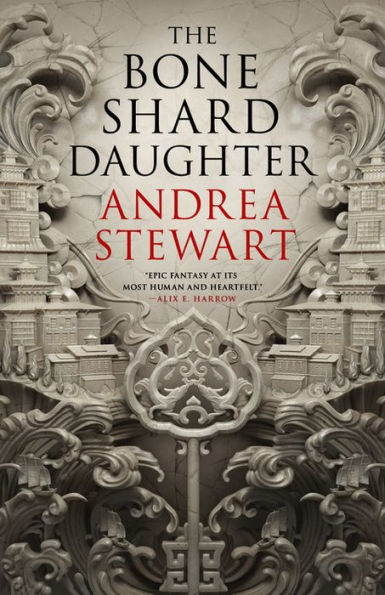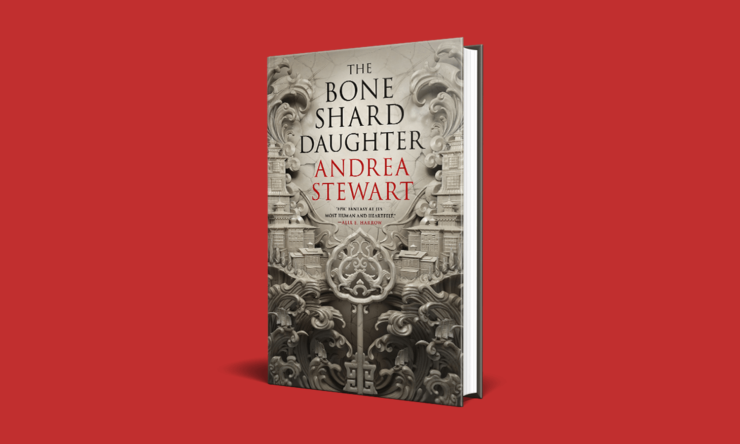Andrea Stewart’s debut novel The Bone Shard Daughter, the first book in the Drowning Empire trilogy, follows four intertwining stories in a vast and rich world inspired by Asian cultures.
Lin is the heir to the throne of the Phoenix Empire, but her father, the current emperor, refuses to recognize her status until she proves herself worthy to him. Trapped in a palace of locked doors, Lin hatches a plan to learn forbidden bone shard magic and overtake her rival Bayan to get her father’s approval.
Phalue, daughter of the governor of Nephilanu Island, discovers that her partner Ranami is working with rebels trying to take down the Phoenix Empire. Facing a radical plan to return power to the people, Phalue struggles to reconcile the ideas she was raised with, the reality she’s confronted with, and the power she has to make change.
Jovis, the most successful smuggler in the last hundred years, sails the Endless Sea searching for his wife Emahla, who disappeared on a ship with blue sails several years ago. After rescuing a child from the annual trepanning day, during which subjects of the Empire have bone shards taken from their skulls, Jovis finds himself living up to a new legend about himself: Jovis, savior of children, accompanied by a mysterious animal companion named Mephisolou, who grants him supernatural strength.
Finally, on Maila Isle on the very outskirts of the Empire, a woman named Sand is harvesting mangos when she falls from a tree and hits her head. Suddenly, the memory fog that keeps the residents of Maila complacent begins to lift from her. Clinging to moments of lucidity, Sand questions why she and the others are on Maila at all and begins to uncover the key to who they truly are.
Buy the Book


The Bone Shard Daughter
There are many things to love in The Bone Shard Daughter. The first line is a powerful hook: “Father told me I’m broken.” In just five words, Stewart piques the reader’s interest in a number of ways: What kind of family dynamic is there that a father would say such a thing to his daughter? How is she “broken”? Is he right? I immediately hoped that the confrontational first line would be challenged in the narrative, and I was deeply satisfied with how Stewart handles Lin’s growth as a character and subverts the idea of Lin being broken.
I found myself daydreaming about Stewart’s worldbuilding long after I finished the book. The world of the Drowning Empire trilogy is fascinating, centering on a premise I’m surprised I haven’t encountered before: People live on floating, migrating islands that drift through the Endless Sea, the bottom of which is unreachable. Stewart does an excellent job of orienting the reader through the islands’ relative locations, even though a map isn’t included (and probably can’t be, given the nature of the islands’ movement).
Although there is no direct connection to our Earth, I also found the temporal setting of The Bone Shard Daughter to be intriguing. In the world of the Drowning Empire, Lin is born in 1522. In our world, the 1500s saw the Joseon dynasty in Korea, the Ming dynasty in China, feudal Japan, the numerous polities of the islands of the Philippines before Spanish colonization, the golden age of Thailand’s Ayutthaya period, the decline of the Silk Road, and the late medieval period of India followed by the Mughal Empire, among others. The architecture and technology allude to those various periods, even while not invoking them specifically—the world is Asian-inspired, after all, not Asian.
Fantasy written by Asian authors often gets connected back to our real-world Asianness, even while work by White authors isn’t arbitrarily tied back to their origins—for example, I don’t think I’ve ever seen someone tie Westeros to George R. R. Martin’s Americanness, or his Irish, French, English, Welsh, and German backgrounds. We simply aren’t given the same freedom to imagine. Dislocated from the sourceland and marginalized by the adopted land, Asian diasporas live in a collective imagination rather than any real-world location. Our dreams defy the concept of a singular “Asian” experience, even as we are inspired by our ancestral homelands. The Bone Shard Daughter pushes the limits on what “Asian-inspired” means, creating a book I’ve always longed for: something that deeply but abstractly reflects Asian aesthetics and sensibilities, while also being an epic fantasy in the Western tradition with all its familiar archetypes and tropes.
Aside from the cultural worldbuilding in The Bone Shard Daughter, Stewart also does an outstanding job with developing bone shard magic. Although the novel is an epic fantasy, bone shard magic is delightfully scifantasy with its execution. The language used in the spells is constructed—a clever callback to the narrative itself, wherein Lin dismantles her father’s chimera-like “constructs” that obey the commands etched on the bones. The materials for performing bone shard magic are organic, but the rules one must learn to perform bone shard magic are like computer programming rules. In essence, Lin must learn enough to “hack” her father’s constructs. Stewart pays close attention to the linguistic details, which absolutely delighted me as a linguist by training.
The Bone Shard Daughter explores three interrelated themes that feed into one another: empire, agency, and identity. The Phoenix Empire literally drains its people of life and potential, as the bone shards collected from trepanning ceremonies and used to power the emperor’s constructs sap their living humans’ energy to work. I’ve previously touched on the cost of colonialism in terms of human potential through the lens of Premee Mohamed’s Beneath the Rising. The opportunity cost that one is born into as a colonial or imperial subject is once more explored in The Bone Shard Daughter and ends up being a recurring theme in speculative fiction written by people in Asian diasporas—unsurprisingly, as many of us are postcolonial subjects.
The place Stewart excels the most is character development, and the fact that there are multiple characters with different relationships to the Phoenix Empire allows Stewart to explore the theme of empire from various angles. Phalue, who is complicit in enabling the Empire as the daughter of a governor, soul-searches about what power means and what her role in overseeing the people of Nephilanu Island truly is. Lin opposes her father’s vision of the Empire and sets out to reshape it according to her notions of governance, but her relationship with power and authority shifts as she discovers who she truly is. Jovis, who would love to ignore the Empire to pursue a personal goal, finds that he is inextricable from it and cannot pretend it doesn’t exist. Even Sand, who is on the outer limits of the Empire, finds that she is closer to the heart of the Empire than she thought. Through their journeys, each character comes to realize that alliances and group efforts are the way to challenge the Empire—a lesson that’s all too applicable to our world.
Agency is another key theme in The Bone Shard Daughter. Each of the four viewpoint characters is given a different lot in life, from Lin at the pinnacle of power, to Sand, who has nothing. Rather than accepting their position in life, each character makes choices on their own behalf to change their circumstances. The theme of agency is perhaps most clearly illustrated through Lin’s story. As she grows as a character, she realizes that no one is truly powerless to make choices over their own life—a sentiment that is echoed in Sand’s story, albeit in a very different way.
Both the ideas of empire and agency culminate in the true thematic heart of The Bone Shard Daughter: personal identity. The message I took away from the novel was that the present you and your choices now define you more than who you were or who people want you to be. Each POV character has a turning point when they realize that what they do in the moment now matters more than who they were in the past. In doing so, each of the characters reshapes their personal narrative to construct a new identity for themselves that empowers them to achieve their goals. Although The Bone Shard Daughter focuses on a personal level of identity, I feel that Stewart’s masterful handling of the theme will ripple out in the next books to destabilize the entire Drowning Empire by questioning other forms of identity.
I’m one of those people who strongly prefers to read standalone novels, and I bounce off most epic fantasy. But The Bone Shard Daughter had me flipping through the pages in two marathon-reading sessions and dying for more by the last sentence. Stewart’s craft is impeccable from the line level to the plot level, and the characters are lively and fascinating. Stewart has proven herself to be a voice to watch out for in epic fantasy. The Bone Shard Daughter is the strongest start to a trilogy I’ve ever read, and I look forward to preordering the next books the instant they go on sale.
The Bone Shard Daughter is available from Orbit.
S. Qiouyi Lu writes, translates, and edits between two coasts of the Pacific. Aer fiction and poetry have appeared in Asimov’s, F&SF, and Strange Horizons, and aer translations have appeared in Clarkesworld. Ae edits the flash fiction and poetry magazine Arsenika and runs microverses, a hub for tiny speculative narratives. You can find out more about S. at aer website or on Twitter and Instagram @sqiouyilu.










